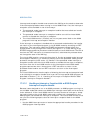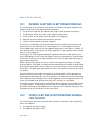
Vol. 3 17-27
8086 EMULATION
Redirecting software interrupts back to the 8086 program potentially speeds up
interrupt handling because a switch back and forth between virtual-8086 mode and
protected mode is not required. This latter interrupt-handling technique is particu-
larly useful for 8086 operating systems (such as MS-DOS) that use the INT n instruc-
tion to call operating system procedures.
The CPUID instruction can be used to verify that the virtual mode extension is imple-
mented on the processor. Bit 1 of the feature flags register (EDX) indicates the avail-
ability of the virtual mode extension (see “CPUID—CPU Identification” in Chapter 3,
“Instruction Set Reference, A-M”, of the Intel® 64 and IA-32 Architectures Software
Developer’s Manual, Volume 2A).
The following sections describe the six methods (or mechanisms) for handling soft-
ware interrupts in virtual-8086 mode. See Section 17.3.2, “Class 2—Maskable Hard-
ware Interrupt Handling in Virtual-8086 Mode Using the Virtual Interrupt
Mechanism”, for a description of the use of the VIF and VIP flags in the EFLAGS
register for handling maskable hardware interrupts.
17.3.3.1 Method 1: Software Interrupt Handling
When the VME flag in control register CR4 is clear and the IOPL field is 3, a Pentium
or later IA-32 processor handles software interrupts in the same manner as they are
handled by an Intel386 or Intel486 processor. It executes an implicit call to the inter
-
Figure 17-5. Software Interrupt Redirection Bit Map in TSS
I/O Map Base
Task-State Segment (TSS)
64H
31
24 23
0
1
1111111
I/O Permission Bit Map
0
I/O map
base must
not exceed
DFFFH.
Last byte of
bit
map must be
Software Interrupt Redirection Bit Map (32 Bytes)


















